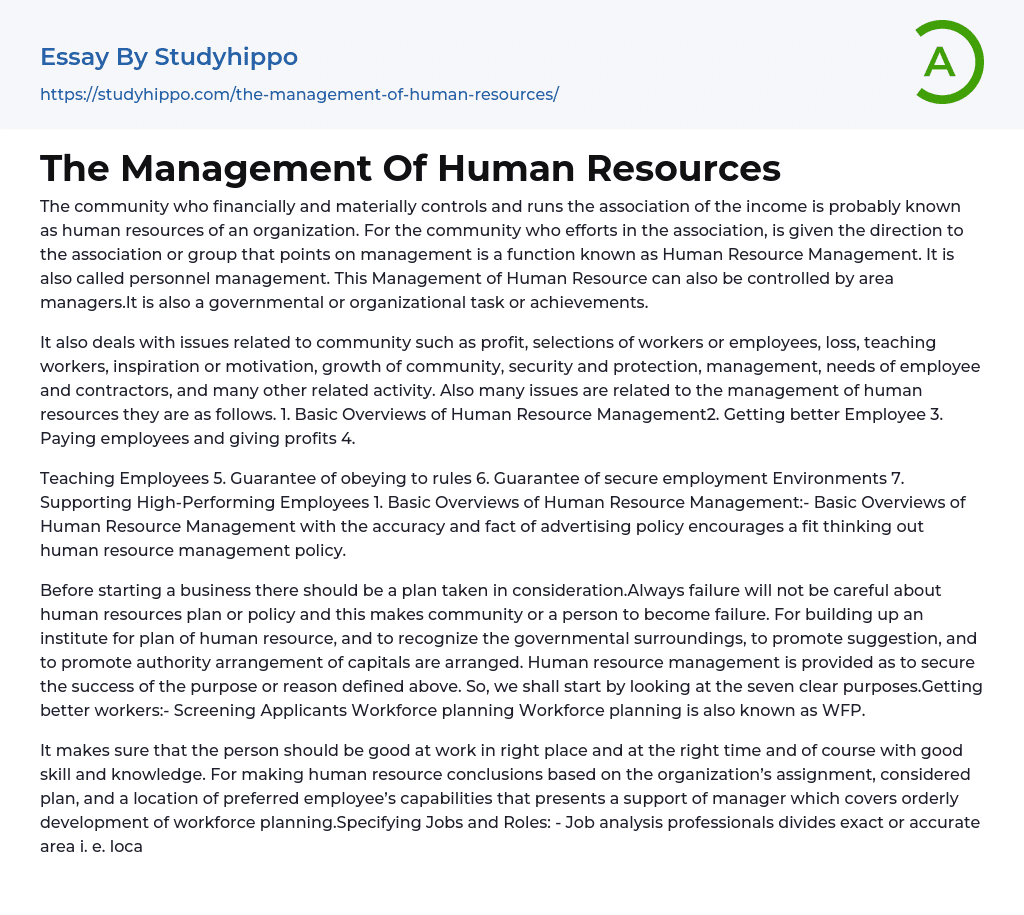Human Resource Management, also referred to as personnel management, is the management function responsible for overseeing the finances and material aspects of an organization's income. This group is often overseen by area managers and is a critical accomplishment for both governmental and organizational entities.
Human Resource Management encompasses numerous aspects concerning the workforce, including profit, recruitment and selection, attrition, training and development, employee motivation and inspiration, community growth, security and safety management. It also caters to the needs of employees and contractors while addressing various issues such as Basic Overviews of Human Resource Management; Enhancing Employee Performance; Compensation and Profit Distribution; among other related activities.
It is essential to promote a sound approach to HR management by accurately and factually presenting basic overviews of human resource management in advertising policies. This involves educating employees, supporting high-perform
...ing staff, and establishing secure employment environments while ensuring compliance with policies and regulations.
When starting a business, it is important to have a pre-existing plan to prevent failure in terms of human resource policies. To create an effective strategy for managing human resources and comply with government mandates, recommendations must be compiled and funding secured. The ultimate goal of human resource management is success, which can be achieved through seven objectives including screening candidates and implementing workforce planning (WFP) to improve the workforce.
Efficient management of human resources guarantees that individuals possessing the suitable expertise and knowledge are appointed in proper roles at the appropriate time. To make informed decisions regarding human resources, it is crucial to take into account an organization's objectives, plans, and the competencies of potential employees. This backing includes a targeted strategy for developing workforce planning. Expert professionals who
specialize in job analysis undertake the responsibility of identifying particular job responsibilities such as location, income, and fitting programs for the company. Position classifiers or job analysts acquire and assess comprehensive information about job duties so as to generate precise job descriptions.
This description explains that every job requires responsibility, knowledge, and training. The job of a job analyst involves creating new jobs or updating existing ones for large institutions or groups. The employee must be knowledgeable about human resources policies, including rules and laws, to discuss promotion opportunities, salaries, and working conditions with potential future employees. It is important to be familiar with association rules. Recruiters may visit college campuses and maintain connections with groups of people to find and recruit for job opportunities. The employee must also be aware of references and job offers.
When considering EEO, it is important to also take into account outsourcing. Outsourcing involves the delegation of internal operations or processes to another party through a contracting transaction. This can include the purchase of services or functions from external companies, while maintaining rights and forming a unique process.
The supplier modifies their method based on customer requests for when, what, and how they want work performed, aiming to improve efficiency and profits. Employment interviewers, including human resources coordinators, development specialists, and consultants, aid in connecting employers with suitable job candidates. Government-employed employer relations representatives maintain relationships with local employers and promote public employment programs and services. Payment and profits refer to the benefits provided by the company or association to its employees.
Aside from receiving discounts and health insurance benefits, Returns Sets aims to upkeep a skillful and experienced workforce by offering affordable
career and personal development training. This includes supervisor development, employee orientation, and leadership development programs to choose from.
The supervisor of the institute does not oversee all of the population. Its role is to facilitate the growth of a specific group of employees within the organization, who receive substantial investments to secure the future of the business. Management development, where directors direct and organize work, is a crucial aspect of organizational success. Resources for management development are devoted to supporting successful leaders within the association, as well as developing new managers.
- Qualities essays
- American Dream essays
- Barriers To Entry essays
- Capitalism essays
- Central Bank essays
- Compensation essays
- Consumerism essays
- Economic Development essays
- Economic Growth essays
- Economic Inequality essays
- Economic System essays
- Economy essays
- Employment essays
- Export essays
- Finance essays
- Free Trade essays
- Gross Domestic Product essays
- Human Development essays
- Income Inequality essays
- Industry essays
- Inflation essays
- International Business essays
- International Trade essays
- Macroeconomics essays
- Materialism essays
- Max Weber essays
- Microeconomics essays
- Minimum Wage essays
- Monetary Policy essays
- Monopoly essays
- Pricing essays
- Profit essays
- Recession essays
- resources essays
- Taxation essays
- Trade essays
- Unemployment essays
- Warehouse essays
- World economy essays
- Code of Ethics essays
- Conflict essays
- Dress Code essays
- Human Resources essays
- Organizational Behavior essays
- Performance essays
- Recruitment essays
- Safety essays
- Business Analysis essays
- Business Plan essays
- Community Development essays




